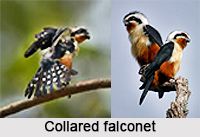 Collared Falconet is a carnivorous bird that belongs to the family of bird of prey bearing the scientific name of "Microhierax caerulescens". Collared falconet is an Indian species of bird of prey in the Falconidae family.
Collared Falconet is a carnivorous bird that belongs to the family of bird of prey bearing the scientific name of "Microhierax caerulescens". Collared falconet is an Indian species of bird of prey in the Falconidae family.
Concentration of Collared Falconet
Collared Falconet is found in the Indian Subcontinent and Southeast Asia, ranging across Bangladesh, Bhutan, Cambodia, India, Laos, Myanmar, Nepal, Thailand, Malaysia, and Vietnam. Its natural habitat is temperate forests, often on the edges of broadleaf forest.
Structure of Collared Falconet
Collared Falconet is a very small falcon. It is just very shrike-like in shape, mainly pied and having bold white supercilia and collar, with relatively heavy double-toothed bill, shortish wings, medium-length tail, strong half-feathered legs and powerful feet. Perches conspicuously on top or edge of tree or bush, often on dead twig, frequently bobbing head and slowly moving tail up and down; wing-tips less than half down tail. Sexes are similar in nature.
Concentration of Collared Falconet
Collared Falconet is concentrated in the mainland of the Southeast Asia. Collared falconet is also found abundant in the Himalayan foothills of north India especially in the parts of northern Uttar Pradesh northwest to Kumaun, and Sikkim, West Bengal, mainly northern Assam and of Nepal and Bhutan, and from Burma especially in the central and east, south to Tenasserim, Thailand with the northwest and west, but not peninsular, also in strip east of central plains, Central and south Laos, Cambodia and Vietnam.
Residence of Collared Falconet
Collared falconet stays in the open deciduous forest, clearings and edges in evergreen forest, abandoned hill cultivation with some trees; often near water. The birds are found mostly 200-800 m, fairly regular to 1,700 m.











